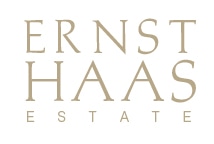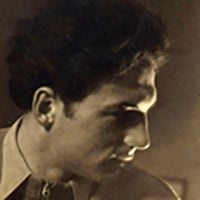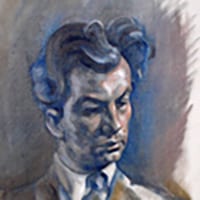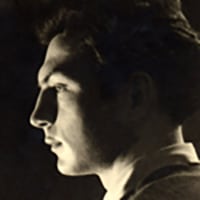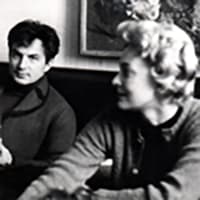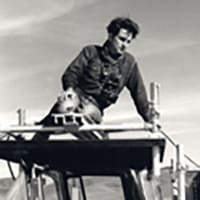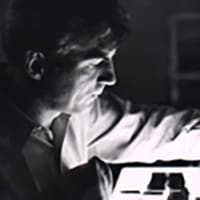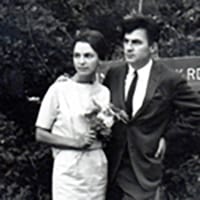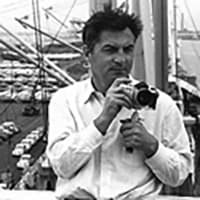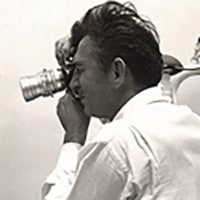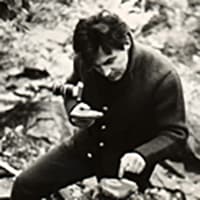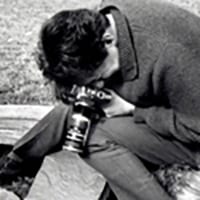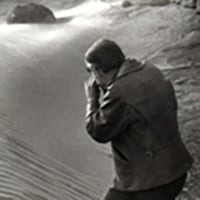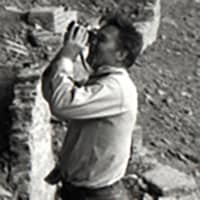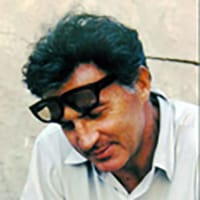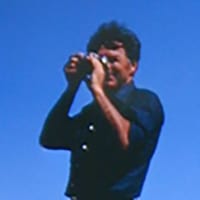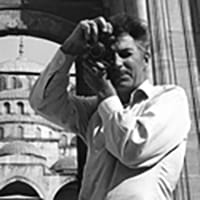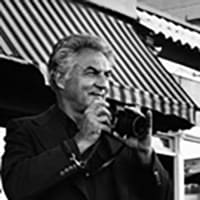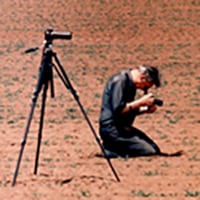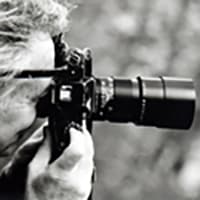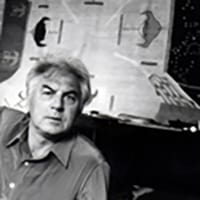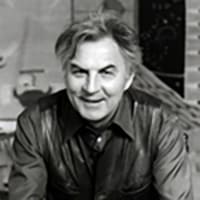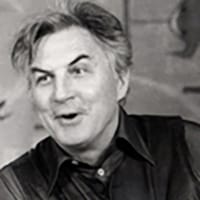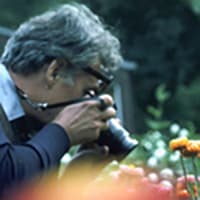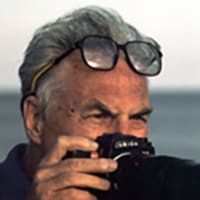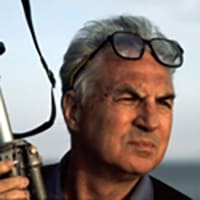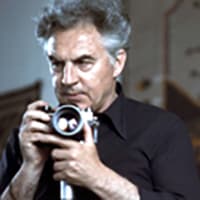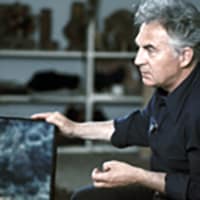Chronology
Born on March 2 in Vienna, Austria, second son of Frederika and Ernst Haas, a high official in the Austrian government. His mother, inspired by the arts, encourages him from early childhood to pursue creative endeavors. She maintains a lifelong correspondence with him, mainly about the artistic and aesthetic aspects of life. His older brother and best friend Fritz is supportive and sympathetic.
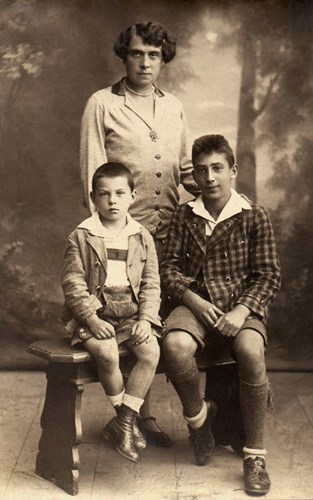
With mother and brother
1935–1939
Attends high school at the LEH Grinzing in Vienna from 1935 to 1938, when it is closed due to invasion of Austria by Germany. Receives diploma from the Rainier Gymnasium, Vienna, 1939.
1940
Father dies. Begins printing from old family negatives. Studies medicine but is prohibited from continuing due to Jewish ancestry.
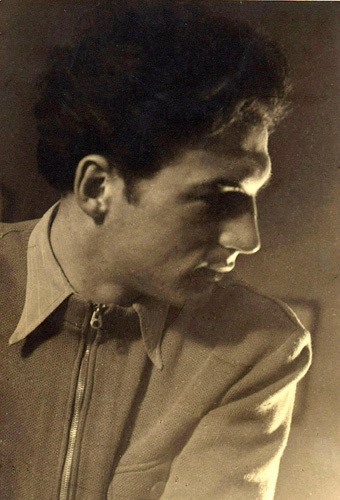
Early portrait
1941
Enters the Graphische Lehr und Versuchsanstalt (Graphic Arts Institute) in Vienna to study photography but leaves after one semester. Shoots still photographs for the Reinhardt film seminar in Berlin.
1943–1945
Works on and off in a photographic studio in Vienna. Makes his first abstract photographs. Teaches photography at the American Red Cross. In their library he discovers The Post’s Camera, edited by Bryan Holme, which influences him on poetry in photography. In this book he sees photographs by Edward Weston, whose ability to transform an object from the real to the surreal profoundly affects him.
1946
Acquires his first camera, a Rolleiflex, on the black market with 10 kilograms of margarine received for his 25th birthday. Travels to Switzerland to meet Alfred Kubler, editor of DU magazine, where he is exposed to the photography of Werner Bischof. Bischof later becomes a close friend and associate at Magnum.
1947
Shows photographs of Vienna during the war in a group exhibition at the American Red Cross headquarters in Vienna. They are seen be Warren Trabant, editor of Heute.
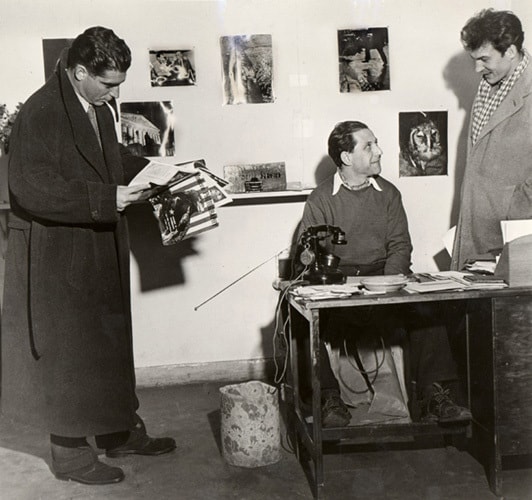
With Robert Capa, 1949
1949
Begins working for Heute with correspondent Inge Morath. First feature article on Viennese homecoming prisoners is published in Heute and later picked up by LIFE. On the basis of this story, Wilson Hicks, picture editor of LIFE, offers him a job as staff photographer, which he declines. At the invitation of Robert Capa he joins Magnum, which he believes will offer him independence as a photographer. Also becomes a shareholder in Magnum. During this time he develops close associations with Capa, Bischof, and Henri Cartier-Bresson. Capa encourages him to pursue his own vision. Begins shooting with a Leica, experimenting with the first color films.
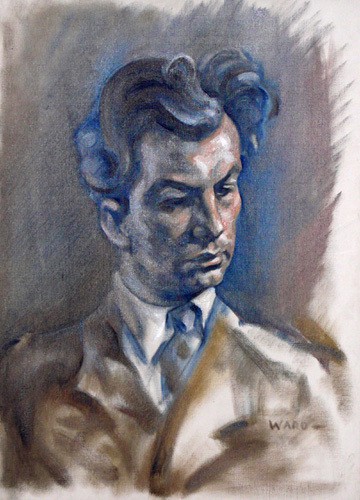
Portrait by Stephen Ward, 1949

With first wife, 1950s
1951
Marries the Countess Antoinette Wenckheim. Visits the United States for the first time on assignment from Robert Capa. Appointed vice-president of Magnum’s American operations.
1952
Hitchhikes throughout New Mexico working on “Land of Enchantment” for LIFE, inspired by his childhood fascination with the Southwest and American Indians.
1953
LIFE publishes its first major color essay “Images of a Magic City” (New York). Travels to Asia to cover the Vietnam war. Free-lance stories included in LIFE, LOOK, Vogue, and Holiday.
1953–1954
In his personal letters begins to question photojournalism assignments, the conflict between editors and photographers, and what he hopes to achieve in life.
1954
Robert Capa and Werner Bischof are killed while on assignment. Upon their deaths becomes a member of the Board of Directors at Magnum.
1955
Haas is included in Steichen’s exhibition The Family of Man, which premieres in 1955 and travels to 38 countries. The exhibition toured the world for eight years, attracting more than 9 million visitors.
Travels to Indonesia.
1954–1956
Photo essays published in LIFE include “Land of Tranquility” (South Africa, 1954); “The Glow of Paris” (1955); and ”Mirror of Venice” (1956). Shoots movie stills for Land of the Pharaohs (1954); Moby Dick (1956); and The Pride and the Passion (1956).
1957
LIFE publishes “Beauty in a Brutal Art,” photographs of the bullfight in Spain. Marks the beginning of his motion studies and the first time this type of color photography is published. Serves as Member of the Executive Committee at Magnum.
1958
Featured in Popular Photography article “The World’s 10 Greatest Photographers.” LIFE publishes “The Magic of Color in Motion,” an essay that explores the possibilities of mixing colors by using slow shutter speeds. Described as “painting with the camera” by critics.
1959
Elected president of Magnum. Edits and designs the exhibition The World as Seen by Magnum Photographers. Begins assignment for General Dynamics. Travels to Norway for Holiday.
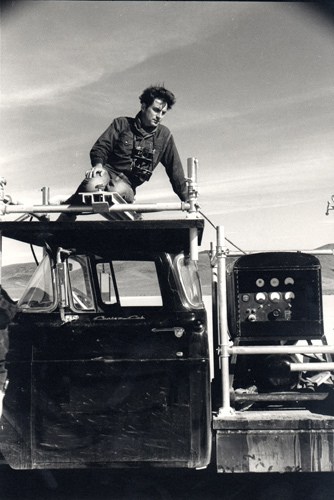
On set of Misfits, 1960
1960
Shoots movie stills for The Misfits. Takes a series of motion photographs for the Lincoln Center Ballet, New York, from which a movie is made. Photographs the Olympics for LIFE. Takes up residency in New York; opens his first studio on East 71st Street.
1962
The Museum of Modern Art in New York presents a ten-year survey of Haas’s color photography. Ernst Haas: Color Photography marks MoMA’s first solo-artist retrospective exhibition dedicated to color work, and takes place during Edward Steichen’s final year as director of the museum’s Department of Photography. It is realized by Steichen’s successor John Szarkowski, and consists of about 80 prints including Haas’s motion studies and color essays. Of Haas’ revelatory color imagery, Steichen has said, “He is a free spirit, untrammelled by tradition and theory, who has gone out and found beauty unparalleled in photography.” This exhibition influenced a generation of photographers and from it Haas became referred to as “The father of color photography”.
Travels to Greece for Holiday; to England for Queen; to Argentina to shoot movie stills for Taras Bulba; and to Tennessee to photograph a story on James Agee for LIFE. Marries Cynthia Buehr Seneque. They will have two children: Alexander (b. 1963) and Victoria (b. 1964). Makes a four-part television series “The Art of Seeing” for public television in New York.

Wedding to second wife, 1962

Volkswagen ad campaign, 1963
1963
Travels with Henri Cartier-Bresson to Mexico on assignment for the Mexican government tourist bureau. Embarks on a landmark advertising campaign for Volkswagen with art director Rolf Gilhausen.
1964
Works as second director for the movie The Bible produced by Dino de Laurentis, with John Huston as director. Responsible for photography on The Creation section, the beginning of his photographic interpretation of Genesis. This movie takes him to the Galapagos Islands, Iceland and Italy.

Photo: Dan Budnick, 1964

Photo: Dan Budnick, 1964
1965
Moves to studio on Seventh Avenue, where he lives for the remainder of his life.
1966
Changes Magnum status to contributing photographer.
1967
Slide presentation of The Creation photographs is shown at the Eleventh Miami Conference of Photojournalists. Photographs in Monument Valley for Holiday.

Photo: Adelaide de Menil, 1967
1968
Travels to India upon invitation from the government, where he observes the plight of the Tibetan refugees and becomes fascinated by buddhism and the mysticism of the Himalayas.
1969
Shoots movie stills for Little Big Man. Prepares photo essays for Holiday and Esquire on American Indians.
1970
Travels to Kenya to photograph animals for the book The Creation.
1971
Publishes first edition of The Creation (Viking), which would eventually sell over 350,000 copies. Excerpts are printed in major photographic magazines. Photographs the Grand Canyon and the southwest for Time-Life Books.
1972–1974
First assignment for Marlboro cigarettes, an account that would continue for twelve years. Invited to The Maine Photographic Workshops, the beginning of a long involvement teaching workshops throughout the world. Photographs extensively in Germany for an upcoming book on that country. In 1972 travels to Rajasthan, India for Stern and to Sikkim and Darjeeling. The Smithsonian Institute sponsors his trip to Bhutan to cover the coronation (1974).

Photo: Ara Guler
early 1970s
Begins working on audio-visuals with a dissolve unit and music in an effort to transform the still image into another form of expression.
1975
Photographs extensively in Venice for the Time-Life Books series “The Great Cities.” Publishes his second book, In America (Viking). Travels to Ladakh for Geo.
1976
Publishes In Deutschland (Viking). Travels to Nepal for his upcoming book on the Himalayas.
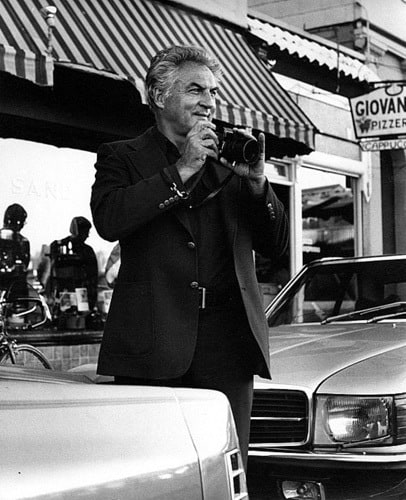
Photo: Marilyn Sanders, 1977
1977
Eastman Kodak Company produces an 18 x 60-foot print titled “Impalas Grazing,” displayed at Grand Central Station in New York. Until then, the largest color print ever produced.
1978
Publishes Himalayan Pilgrimage (Viking) with text by Gisela Minke.
1979
Participates in Venezia ’79, La Fotografia. Teaches a workshop, exhibits his photographs, and gives audio-visual presentations on “Venice” and “Abstracts.” Covers the Jazz Festival and Mardi Gras in New Orleans for Geo.
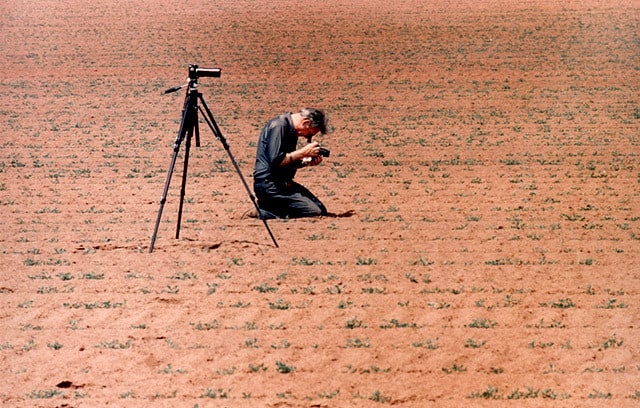
In the desert, 1979
1980
Publishes The Creation, a limited-edition portfolio of dye transfer prints with Daniel Wolf Press. Travels to Japan for Fujitsu Limited. Begins working on book devoted to that country with Takiko Kawai. Photographs the Lake Placid Winter Olympics. Begins a project illustrating the poetry of Rainer Maria Rilke, whose writings inspired him throughout his life.
1980–1981
Creates the educational audio-visual, “To Dream With Open Eyes,” and “Expanding Photographic Vision: The Sight and Insight of Ernst Haas,” produced by The Media Loft, Inc. Shoots movie stills for Quest of Fire and Heaven’s Gate in 1981.
1982
Mother dies in Vienna.
1983
Produces audio-visual “Flower Show” for the St. Louis Arboretum. Publishes Flowers, his second limited-edition portfolio of dye-transfer prints. Publishes revised edition of The Creation.
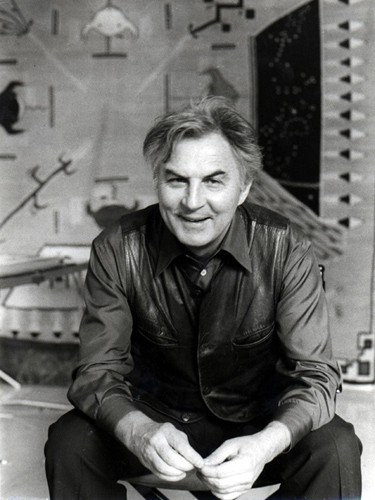
In studio, 1980s
1984
Photographs the Summer Olympics in Los Angeles for a Chrysler Corporation advertising campaign. Travels to Japan for a workshop and photographs extensively for his upcoming book.
1985
Focus on New Zealand trip sponsored by New Zealand Center for Photography and the Brooks Institute in Santa Barbara.
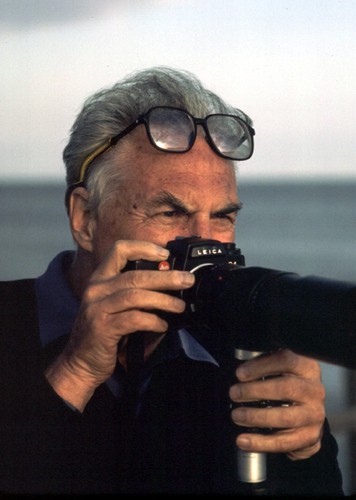
Photo: Todd Wenstein
1986
Completes his last audio-visual slide show, “Abstracts.” Participates in the Ansel Adams Workshop in Yosemite. At the First International Photography Congress in Rockport, Maine, conducts the opening and closing ceremonies stressing the importance of poetry in photography. “Abstract” audio-visual show presented in its most complete form. Dies of a stroke on September 12 in New York.
1987
ASMP establishes the Ernst Haas Award for Creative Photography as part of its annual awards.
1988
The Maine Photographic Workshops awards The Ernst Haas Photographers Grant, funded by Kodak.
1998
The Ernst Haas Studio’s entire archive is sent to London and housed at the Hulton Getty Picture Library as part of a licensing agreement with Getty Images.
1999
The Ernst Haas Memorial Collection is established at the Portland Museum of Art, Maine.
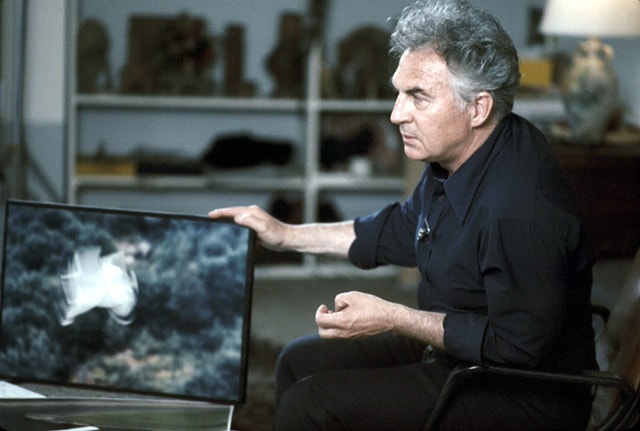
Photo: Todd Weinstein
CLICK FOR FULL VIEW:
